The post Newmediarights.org: Know your digital rights appeared first on Socialbrite.
]]>New Media Rights: Know your online rights from JD Lasica on Vimeo.
Target audience: Online publishers, nonprofits, cause organizations, bloggers, podcasters.
 If you work in online publishing, sooner or later you’ll bump up against the laws surrounding the Internet and intellectual property.
If you work in online publishing, sooner or later you’ll bump up against the laws surrounding the Internet and intellectual property.
Enter New Media Rights, a San Diego-based nonprofit that provides assistance regarding new media, technology and copyright issues and also promotes citizen media efforts. I recently sat down with the organization’s communications and information officer, Mera Szendro Bok.
If you receive a DMCA takedown notice, if one of your properties aggregates content from other sites, if you have a question about how fair use applies to a specific situation, New Media Rights offers a hotline where you can get free legal advice: (619) 591-8870.
Watch, embed or download the video on Vimeo.
Cultivating investigative journalism and citizen media
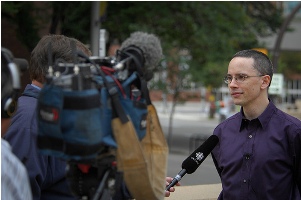 The nonprofit operates a public media studio helping local producers, who can get free access to a high-end Canon XL2 video camera, shotgun and lavalier microphones, a green screen, a dual-monitor G5 apple workstation, Final Cut Studio (including Motion, Soundtrack, and LiveType), as well as open-source programs for image editing, and video and audio capturing. See the NMR Declaration of a grassroots revolution. It’s all part of the organization’s efforts to promote community journalism and investigative reporting, especially at the local level.
The nonprofit operates a public media studio helping local producers, who can get free access to a high-end Canon XL2 video camera, shotgun and lavalier microphones, a green screen, a dual-monitor G5 apple workstation, Final Cut Studio (including Motion, Soundtrack, and LiveType), as well as open-source programs for image editing, and video and audio capturing. See the NMR Declaration of a grassroots revolution. It’s all part of the organization’s efforts to promote community journalism and investigative reporting, especially at the local level.
New Media Rights also is working with the Mozilla Foundation to create Drumbeat San Diego (which I labeled San Diego Drumbeat in the video) to advance social activism, art projects and other community projects. The goal, they explain, is to create “a participatory event that will embody the best principles of Open Web, creating a venue for diverse groups to come together to discuss the future of the Internet, and advance projects that have an impact in our community and the broader world. Pitch a project, lend your skills, and get involved at Drumbeat.”
“It’s important that people be able to innovate and create new services,” Mera says. “I’m interested in creating more diversity of voices on television, on the Internet,” and 3-year-old New Media Rights is now a key player in the conversation around Internet governance.
I’m enormously grateful to Mera and her colleagues at New Media Rights for playing such a pivotal role in protecting our online freedoms and advancing citizen media.
The interview took place at last month’s Blogworld Expo in Las Vegas. I apologize for the poor lighting and all the noise in the background (note to self: next time find an empty room).
Additional legal resources for online publishers
• New Media Rights publishes how-to and legal guides for online publishers.
• See Socialbrite’s rich roundup of resources related to grassroots media and the law, including articles and tutorials on your rights as a photographer and videographer, whether you need your video subjects to sign a model release form and other materials.
• Also see Socialbrite’s best-on-the-Web directories of free photos, free music and free video footage.
• See the Mid-Peninsula Community Media Center, south of San Francisco, and the Open Media Foundation/Denver Open Media for two more grassroots media production studios.
• The Electronic Frontier Foundation has long been defending digital rights and civil liberties in the online world.
• Why isn’t law part of the social media conversation? (Socialmedia.biz)
If you know of other legal resources or grassroots media studios for online publishers, please add them in the comments below.
 This work is licensed under a Creative Commons Attribution 3.0 Unported.
This work is licensed under a Creative Commons Attribution 3.0 Unported.
The post Newmediarights.org: Know your digital rights appeared first on Socialbrite.
]]>The post The rules around capturing public performances appeared first on Socialbrite.
]]>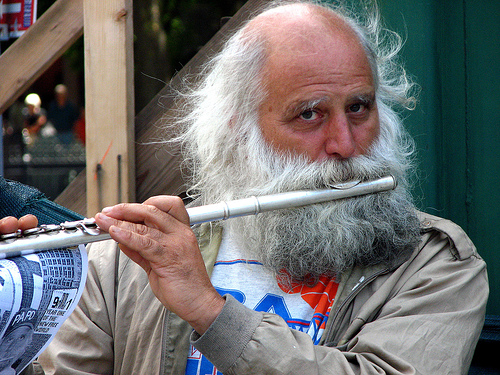
Can you shoot video or take a photo of a street artist in public — and post it on your blog?
 Are you allowed to shoot video or take a photo or record music of a musician or street artist performing in a public place and post it online?
Are you allowed to shoot video or take a photo or record music of a musician or street artist performing in a public place and post it online?
Attorney Colette Vogele of the San Francisco law firm Vogele & Associates offers the following thoughts (though this does not constitute legal advice):
(1) For copyright it depends on a couple facts. In the first instance, there is generally no copyright interest in a street performance because (presumably) the performer he has not “fixed” (eg., recorded) his performance in a “tangible medium of expression” (eg., a videotape, or computer disk). That’s the good news, but don’t get excited yet. You’ve got two other potential copyright problems, but ONLY IF the performance you record is considered a “live musical performance.”
The two problems arise under section 1101 of the Copyright Act and the criminal anti-bootlegging statue that Congress passed a number of years ago (Title 18 USC 2319A).
Section 1101 requires “consent of the performer” if you “fix the … sounds and images of a live musical performance” (which is what you’ve done in making the recording, assuming it’s a “live musical performance”). It also would require consent if you “transmit … to the public” (which is what your blog would do).
So, unfortunately, despite the performer’s lack of other copyright interest (since he hasn’t fixed the performance), you would need his permission to make the recording and then post it on your blog. If the performer tries to assert these rights, you might argue that you have an implied license. Because the street performer is performing in an openly public place, and he (presumably) sees that you’re videotaping him and others are probably photographing him, you probably have a good argument for an implied license to “fix the sounds and images.”
But whether you have an implied license to then “transmit it to the public” is a little more difficult. I don’t know the answer off hand, but in this day and age, doesn’t everyone know that if they are doing something interesting in public and it’s being videotaped, it’ll end up on the Internet sooner or later? (That last bit isn’t sound legal reasoning, but you get the idea.)
A final question is what constitutes a “live musical performance” triggering this section. The Act is, unfortunately, not clear on this. There’s no definition of the phrase, or of the individual words, but the term “performance” is defined broadly. I don’t know the answer specifically, but I’d say off hand that if the performer is not singing or playing music, you can try to argue that the performance doesn’t fall within this section because it’s not “musical.”
In the criminal anti-bootlegging act, the definition of “trafficking” requires a transfer of the bootlegged performance “as consideration for anything of value.” This suggests to me that if you’re doing this non-commercially, then you’re not providing the copy on the blog “as consideration for anything of value” and thus not in violation of the criminal act. So I think you’re in the clear on this one. BTW, this criminal act is the subject of some recent litigation. The Act arguably violates the copyright clause of the Constitution because it gives someone a time-unlimited right to control a public performance (it’s a limited times argument). This issue is working its way up through the federal courts as we speak.
(2) He may try to claim a right of publicity, but I think you’re safe on that for two reasons (at least under California laws): (a) he’s performing in an entirely public place without any restrictions, he sees that people are photographing him and taping him; (b) your use is “not commercial” (speaking conservatively, this means that you receive NO $$$ from the blog that is hosting the tape). The Right of Publicity in California extends only to commercial uses of one’s identity/image/likeness/voice etc. A third reason may be applicable: (c) There’s an exception to the Right of Publicity for “any news, public affairs, or sports broadcast or account, or any political campaign.” To my knowledge, this has not been tested legally, but if your blog is considered “news reporting” then you’d fall w/i that exception, or, if the street musician is a political candidate you’re definitely in the clear.
(3) This is a bit of a stretch, but the performer may claim trademark interests. For example, if he’s wearing clothing that identifies himself and his trademark for services (performaces?) he provides, then your putting them on your website might suggest an affiliation with him. The key for TM infringement is likelihood of consumer confusion. Unless you’re a competing performer and putting a video of him on your blog (e.g., to suggest an affiliation/endorsement by him), then you’re not going to even come close to consumer confusion.
Image at top: Artista de rua by Delcio G.P. Filho
Related
• Do video producers need a publicity release waiver?
• Model release form for video producers and photographers and downloadable form (Socialbrite)
• Podcasting Legal Guide: Rules for the Revolution (Socialbrite)
• Guide to shooting photos in public (Socialbrite)
• Your rights as a photographer (Socialbrite)
• What is off-limits to a documentary filmmaker? (Socialbrite)
• U.S. Code collection: Unauthorized fixation and trafficking in sound recordings and music videos (Cornell University Law School)
• U.S. Code collection: Title 18 — Crimes and Criminal Procedure (Cornell University Law School)
The post The rules around capturing public performances appeared first on Socialbrite.
]]>The post Do video producers need a publicity release waiver? appeared first on Socialbrite.
]]> Here’s a 3-minute video interview with Colette Vogele, an intellectual property attorney in San Francisco, regarding whether video producers and video bloggers need to obtain a right of publicity release form from the subjects of their videos if they plan on using the video commercially. For many purposes online, nonprofits fall into the “commercial use” category. And a blogger who places ads on her site may be considered a commercial operation.
Here’s a 3-minute video interview with Colette Vogele, an intellectual property attorney in San Francisco, regarding whether video producers and video bloggers need to obtain a right of publicity release form from the subjects of their videos if they plan on using the video commercially. For many purposes online, nonprofits fall into the “commercial use” category. And a blogger who places ads on her site may be considered a commercial operation.
Colette also offered these written observations about the rules around capturing performances in public. California in particular provides additional protections that give the subjects of videos a right of publicity.
The contract can go by many names: publicity release form, model release waiver, legal release form. See the model release form for video producers on our site and tailor it to your organization or project as you’d like.
The interview was conducted at a video conference at which Colette spoke about these issues in June 2007, and the interview was uploaded to the Internet Archive.
Related
• Model release form for video producers and photographers and printable model release (Socialbrite)
• Guide to shooting photos in public (Socialbrite)
• Your rights as a photographer (Socialbrite)
• What is off-limits to a documentary filmmaker? (Socialbrite)
• Podcasting Legal Guide: Rules for the Revolution (Socialbrite)
 This work is licensed under a Creative Commons Attribution 3.0 Unported.
This work is licensed under a Creative Commons Attribution 3.0 Unported.
The post Do video producers need a publicity release waiver? appeared first on Socialbrite.
]]>The post Freedom of information: It’s for everyone appeared first on Socialbrite.
]]>Target audience: Nonprofits, cause organizations, journalists, NGOs, general public.
Guest post by Dan Gillmor
Director, Center for Citizen Media
“Freedom of information” is not just a phrase. It is a pillar of an open and free society.
Nowhere has that pillar been more solid than in the United States. Congress and most state legislatures have enacted laws designed to keep governments more honest by opening up the information flow.
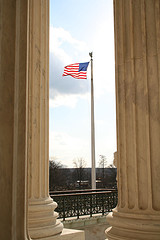 A key point about the federal Freedom of Information Act (FOIA) and various state “open records” laws: They are not designed solely for journalists, although that is the popular mythology, sometimes encouraged by professional journalists. They are for everyone, not any special profession or group of people.
A key point about the federal Freedom of Information Act (FOIA) and various state “open records” laws: They are not designed solely for journalists, although that is the popular mythology, sometimes encouraged by professional journalists. They are for everyone, not any special profession or group of people.
Indeed, the uses of open-records laws vary widely. Among other uses: Lawyers file requests for information on behalf of corporate and other clients. Interest groups file to pry loose information of various kinds. Journalists file requests so they can cover the way governments do the people’s business. And average folks file requests to learn about governmental activities that escape the notice of the traditional media.
So is the battle won against government secrecy? Not by a long shot. Many in government work constantly to restrict information, sometimes for sound policy reasons but, as history shows, more often to bury their mistakes and misdeeds.
When recalcitrant record-keepers face open-records laws, they employ a variety of tactics, such as stalling and outright obstruction, to prevent us from getting the information to which we are entitled. Unfortunately, there are few sanctions in federal law and many state laws to deter such behavior.
The FOIA was first enacted in 1966. It has been amended several times, and Congress is now looking at a major — and welcome — overhaul to strengthen its provisions.
Resources
Many organizations have created excellent guides to the FOIA and state laws. Here are some links to the best such resources:
- Freedom of Information portal, Society of Professional Journalists
- First Amendment Center, Vanderbilt University
- Freedom of Information Center, University of Missouri.
- Freedom of Information Clearinghouse, Public Citizen advocacy group
- FOIA information, National Security Archive
- National Freedom of Information Coalition
- How to Use the Federal FOI Act, Reporters Committee on Freedom of the Press
Credit: Photo of U.S. flag by redperm
Please comment on, correct or expand upon this article.
Related
• The Bloggers’ FAQ – Freedom of Information Act (eff)
 This work is licensed under a Creative Commons Attribution-NonCommercial-NoDerivs 3.0 Unported.
This work is licensed under a Creative Commons Attribution-NonCommercial-NoDerivs 3.0 Unported.
The post Freedom of information: It’s for everyone appeared first on Socialbrite.
]]>The post How to prevent against online libel and defamation appeared first on Socialbrite.
]]>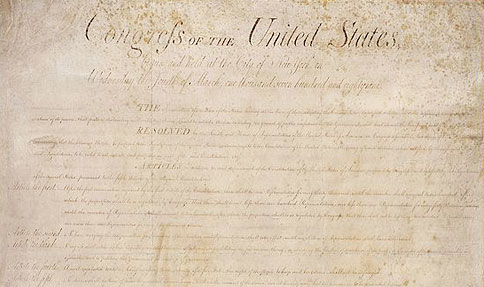
The Bill of Rights
A brief guide for citizen journalists and bloggers
Target audience: Journalists, bloggers, nonprofits, cause organizations, NGOs, general public.
Guest post by Mitch Ratcliffe
RatcliffeBlog
There is much that bloggers can learn from journalists, who have learned how to cause the most trouble possible without landing in jail over the course of centuries. I highly recommend you pick up a copy of The Associated Press Stylebook and Briefing on Media Law ($13 at Amazon.com, which is the essential text for many journalists.
In addition, here’s a good source for students and other beginners.
If you want to go deep and learn a lot, read this piece from the Massachusetts Bar Association’s Journalists’ Handbook.
It’s worth understanding this stuff even if you don’t want to be a journalist, because anyone can be sued for libel, slander or defamation.
The first thing to understand about all subjects relating to journalists’ privileges is that they are different everywhere. There is no international standard set of laws, though journalistic professional societies have pressed for these kinds of uniform expectations. Most of what I’ll lay out here relates to the United States, where the press enjoy the most liberal protections available. In Canada, for example, there is no presumption that a journalist can protect their source. In much of Europe, the subjects of photographs retain far greater control of pictures through their moral rights (PDF), or “droit moral,” which provides both the photographer and the subject protection from the unauthorized reuse of the image in whole or in part — juxtaposing the image of a person into an advertisement, for instance, which is common in digital media is prohibited without their permission.
Elements of defamation
Defamation, slander and libel are the same thing, essentially, but each is defined based on the way a false statement about a person is conveyed. According to ExpertLaw.com’s entry on Defamation, Libel and Slander Law, the general principle behind all three must include the following elements:
1. A false and defamatory statement concerning another;
2. The unprivileged publication of the statement to a third party (that is, somebody other than the person defamed by the statement);
3. If the defamatory matter is of public concern, fault amounting at least to negligence on the part of the publisher; and
4. Damage to the plaintiff.
In the context of defamation law, a statement is “published” when it is made to the third party. That term does not mean that the statement has to be in print.
Damages are typically to the reputation of the plaintiff, but depending upon the laws of the jurisdiction it may be enough to establish mental anguish.
Most jurisdictions also recognize “per se” defamation, where the allegations are presumed to cause damage to the plaintiff. Typically, the following may consititute defamation per se:
• Attacks on a person’s professional character or standing;
• Allegations that an unmarried person is unchaste;
• Allegations that a person is infected with a sexually transmitted disease;
• Allegations that the person has committed a crime of moral turpitude.
Libel is committed when a statement that meets the standard above is published in a document, whether a newspaper, magazine, book or Web site. Bloggers need to keep this firmly in mind when writing about someone, especially someone who is not a public figure (we’ll get to that in a moment).
A slander is a spoken defamation, whether that act of speech is public and one-time or recorded and redistributed. Slander also includes defamation by gesture, which could include making a gesture that suggests professional incompetence or mental illness. Slander carries the additional burden for a plaintiff of having to prove that they suffered actual loss due to the false statement.
If you are webcasting, podcasting, producing digital video or otherwise using the Internet to convey information that may be construed to be slanderous, this is the branch of defamation law about which you need to be aware. RTNDA, the Association of Electronic Journalists, offers a deep resource on the use of many different kinds of information in a broadcast that deals with a variety of liabilities and ethical questions radio and television journalists face.
In all cases, the truth is an absolute defense against charges of libel, slander or defamation (except in totalitarian countries or those not under the rule of law, where a judge can rule arbitrarily in favor of a powerful person). If you are going to call someone “a crook” or “a philanderer,” for example, be sure that you can prove they are a criminal or that they are stepping out on their spouse or carrying on multiple affairs simultaneously. Be ready for challenges to your proof, so don’t take for granted that one item of proof is sufficient.
But the truth is a relative thing, because public figures are the subject of varied opinions which the writer or producer is largely convinced. Public figures have to prove that the writer or speaker willfully ignored the truth or acted with flagrant disregard to the truth. And that is hard to prove. In the case of Dan Rather’s broadcast accusing President Bush of having avoided his National Guard service based on documents it failed to vet completely, the fact that it involved a source’s documents insulated CBS from charges of slander and libel (since they both broadcast and published articles on the cbs.com Web site).
Fox News has mastered the practice of deflecting an accusation by attribution, as in the phrase “people say…” or “according to sources” before leveling an untrue or highly opinionated statement. This is not a defense against libel or slander if the criteria described above are met. The burden for a journalist would then fall to the question of whether a source really made the accusation. And this is where the issue of confidentiality comes in.
Confidentiality
The confidentiality of sources involves protections that are somewhat mythical. In many jurisdictions, including the United States, there is no guarantee that a journalist can protect her sources. It’s not in the U.S. Constitution, but has been interpreted to be a journalist’s privilege in a number of state and federal cases. Shield laws have been passed in many cities and states, but these do not protect someone publishing on the Web, who may be indicted in another jurisdiction that has no such laws.
Confidentiality is grossly abused these days, in my humble opinion. It is used by government and corporate officials who should be on the record when they launch test balloons, make attacks on opponents and much else. It is also just plain lazy on many journalists’ part, because they should use a background statement to delve into the truth in order to get the facts on the record. But in the race to make a scoop — and, unfortunately, many journalists just think being first, rather than being complete and accurate, is paramount — solid sourcing often goes out the window.
Sources can sue you for libel or slander, as well, if they dispute what words you put in their mouths. This is why a journalist’s notes are so terribly important. In one case, a journalist whose source disputed a phrase lost the case because the words were in his notebook but not in quotes. A journalist learns to annotate carefully because of these kinds of realities.
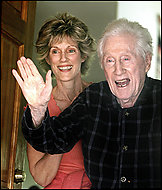
Woodward and Bernstein of the Washington Post made a historically important and correct decision to protect the identity of a senior Nixon Administration official who guided them in their reporting of Watergate: Deep Throat. In May 2005, a former top FBI official named Mark Felt went public in Vanity Fair and acknowledged he was Deep Throat, but Woodward and Bernstein and their editors never revealed their source.
If the source has something to lose and can demonstrate it is materially important to them, then confidentiality may be necessary. If confidentiality is a convenience for the source, you’re better off doing more footwork yourself.
Attribution
This brings us to the issue of attribution and knowing when and why to go from being on the record with a source. Always begin a conversation by identifying yourself as a journalist (or a blogger writing “on the record”), if you want to enjoy any of the protections normally accorded to a journalist; begin and stay on the record until it becomes necessary to go off the record.
After “on the record,” which means you can write or broadcast anything said in the conversation, comes terms such as “on background,” “off the record” and their many hues. In a background conversation, you can write down what is being said but cannot attribute it directly to the source — they become generally identifiable to the reader as “a source in the Defense Department” or “a senior manager at Example Corp.” Remember that background information still needs to be confirmed elsewhere, so don’t be afraid to take the conversation back on the record to try to get the information in an attributed quote; background conversations are a matter of convenience for the source and are increasingly given by news organizations only with a compelling reason.
We’re talking here about how you handle relationships with people. We all know that there are times and circumstances that demand we protect confidentiality. Sometimes a source is giving you information that will get the person who really needs to be on the record to speak, because you come to them with information that, once they know you have it, they have to address on the record. This has worked for me with corporations, two White House administrations and a variety of other situations. What I want to emphasize is that a background quote or an off-the-record or confidential source does not make a publishable story in all but the most extreme cases. Can you prevent a catastrophe with an off-the-record quote? Publish! If it’s a matter of getting a scoop, do more legwork.
That’s it in a nutshell, the beginning of a lifetime of exploration and growing subtlety if you want to jump into the journalist’s role in society.
Related
• See other Socialbrite articles on law and citizen media
 This work is licensed under a Creative Commons Attribution 3.0 Unported.
This work is licensed under a Creative Commons Attribution 3.0 Unported.
The post How to prevent against online libel and defamation appeared first on Socialbrite.
]]>The post Socialbrite releases Creative Commons plug-in appeared first on Socialbrite.
]]>
 We’re happy to launch today with the news that our lead developer, Esteban Panzeri (above), is releasing a new WordPress plug-in to the WordPress community. It’s called Creative Commons Reloaded, and it lets individual blogs or group blogs assign Creative Commons licenses on a post-by-post basis.
We’re happy to launch today with the news that our lead developer, Esteban Panzeri (above), is releasing a new WordPress plug-in to the WordPress community. It’s called Creative Commons Reloaded, and it lets individual blogs or group blogs assign Creative Commons licenses on a post-by-post basis.
That’s especially useful at sites like Socialbrite, where some of us (me, Beth, Ken) release our works under a CC Attribution license, while others (Amy, John, Katrin) use a CC Attribution Noncommercial Share-Alike license. Creative Commons lets you fine-tune your copyright, allowing others to reuse it as you specify.
I asked Esteban, a tech guru/analyst at Lenovo in Buenos Aires, why he developed the plug-in on his own time. “I think the old copyright model is outdated,” he said. “It does not fit the digital era. I’m convinced that it strangles creativity and it is bad for business. Creative Commons is a good step in the right direction. With so many excellent blogs out there, I thought it would be a nice way to help all those authors get a simple way to license their work. That and ‘giving back to the community’ that has helped me achieve so much.”
He cited Michael Geist’s recent post pointing to a new Harvard Business Chool working paper that suggests weaker copyright protection has benefited society.
Esteban — who happens to be the most capable programmer I’ve ever worked with (he Twitters in English here and in Spanish here) — was quick to credit Nathan Yergler (whom I worked with four years ago when he developed the original CC Uploader app for Ourmedia), who created the original WordPress plug-in, WpLicense, which applies to an entire site and which CC Reloaded is built upon.
Some details about the plug-in:
• Esteban is aiming to post it on the WordPress.org plug-in directory on July 6. It’s already fully functional on this blog (see below) and he’s now working on the documentation.
• On your Add New Post page, you’ll see a “Creative Commons Licensing” area that lets you check boxes sayng whether you want to allow others to remix your work, to allow or prohibit commercial uses and to require Share-Alike usage. You can also choose a jurisdiction for your license if you’d like.
• You can customize the look as you’d like. We chose a brighter Creative Commons logo, and styled it with a top border and tinted background by tweaking the CSS.
Thanks, Esteban, nice to see that your development work on Socialbrite is already paying dividends!
Update:
• See Socialbrite developer releases CC plug-in
• You can find the plug-in here: WP License Reloaded
The post Socialbrite releases Creative Commons plug-in appeared first on Socialbrite.
]]>The post License your photos and more on Facebook appeared first on Socialbrite.
]]>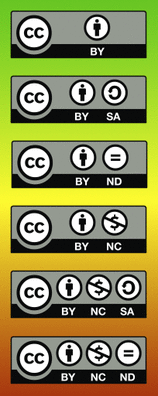 This blog has a Creative Commons license. Why? Because I want people to know that I expect them to share things they find interesting, or to help further the conversation but that in sharing, others need to keep the content free, too. Because Creative Commons licenses help creators, sharers, and readers enjoy online content respectfully. So, when I saw that Creative Commons released a version of the licensing and an application for Facebook, I had to check it out!
This blog has a Creative Commons license. Why? Because I want people to know that I expect them to share things they find interesting, or to help further the conversation but that in sharing, others need to keep the content free, too. Because Creative Commons licenses help creators, sharers, and readers enjoy online content respectfully. So, when I saw that Creative Commons released a version of the licensing and an application for Facebook, I had to check it out!
“CC licenses enable anyone to specify to the public how they want their work to be used. If you’re a photographer, you might be happy to let someone use your photos so long as they give you credit. CC licenses make it easier to be clear about how you want your content used.
The Creative Commons License application allows users to choose one of the six Creative Commons licenses to apply to the content they upload to Facebook.”
Why use Creative Commons in Facebook?
You may be licensing your blog posts or website content under a CC license, like I do (you can see the license information in the right hand column). Maybe you use Flickr and share your photos there under a CC license as well. Why, because you want others to know they can share or post your cool photos so long as they give attribution (or any other stipulated criteria you’ve set via the licensing options).
Facebook has a great deal of content you are creating, uploading, posting, and sharing. Why not license that as well so that your Flickr photos and your Facebook photos are both included. So that your blog posts and your status messages are both licensed.
How do you get started?
 It’s pretty easy! Just visit the Creative Commons Facebook application page here (be sure you are logged into Facebook first) to add the application and select your license. Something to keep in mind: “Because of the way Facebook applications work, users cannot select a license per-photo or video, and must choose a CC license for all items of a particular type of media.”
It’s pretty easy! Just visit the Creative Commons Facebook application page here (be sure you are logged into Facebook first) to add the application and select your license. Something to keep in mind: “Because of the way Facebook applications work, users cannot select a license per-photo or video, and must choose a CC license for all items of a particular type of media.”
If you want to suggest ideas or features for the Facebook application, you can visit the Creative Commons wiki.
What do you think?
Will you use the application? Do you use Creative Commons on other online spaces as an individual or as an organization, like a blog or website? How did you select which license you wanted to use?
This post originally appeared at Amy Sample Ward’s Version of NPTech.
 This work is licensed under a Creative Commons Attribution-NonCommercial-ShareAlike 3.0 Unported.
This work is licensed under a Creative Commons Attribution-NonCommercial-ShareAlike 3.0 Unported.
The post License your photos and more on Facebook appeared first on Socialbrite.
]]>The post What is off-limits to a documentary filmmaker? appeared first on Socialbrite.
]]>Guest post by Peter Jaszi
Professor of Law, Washington College of Law, American University
The answers to some of filmmakers’ most common clearance questions don’t really lie in the realm of “fair use” at all, but fall under the heading of “free use.” Some examples:
- Buildings that can be seen from public areas can be filmed for any purpose. Although there has been copyright in architectural works in the United States since 1990, the U.S. Copyright Act includes an exemption for filming. It doesn’t matter whether the building is the subject of the film or an incidental background.
- Federal government works enjoy no copyright protection whatsoever, whether they are the words of federal government employees or footage taken by camerapeople in civilian or military service. The purpose for which you use the material – as well as the source from which you obtain it – are irrelevant from a copyright perspective.
- Public domain works (such as 19th century paintings or medieval manuscripts) in museums or private collections are free for use as well, if you have access to a reproduction. Many institutions claim copyright in their own photographs of old objects in their collections. But if you have a different source, you’re free to proceed, without a license from the collection.
- For most documentary projects, filmmakers don’t have to be concerned about the so-called “right of publicity” that exists under some state laws. The cases (and sometimes the statutes themselves) make it clear that the right bars only the commercial exploitation of celebrities’ “persona,” and First Amendment-protected expressive uses are specifically exempted.
- In answer to a common (but not intellectual property-related) question, documentarians don’t need photo releases from individuals who are filmed in parks, streets or other public places where they have no expectation of privacy. If you single out an individual for special attention, you may a need a release.
Related
• Filmmakers’ best practices in fair use
• The rules around capturing public performances
• Guide to shooting photos in public
• Your rights as a photographer
 This work is licensed under a Creative Commons Attribution 3.0 Unported.
This work is licensed under a Creative Commons Attribution 3.0 Unported.
The post What is off-limits to a documentary filmmaker? appeared first on Socialbrite.
]]>The post Guide to shooting photos in public appeared first on Socialbrite.
]]>Target audience: Cause organizations, nonprofits, NGOs, journalists, general public. This is part of our ongoing series designed to help nonprofits and other organizations learn how to use and create media.
 When is it all right to take photos of strangers in public?
When is it all right to take photos of strangers in public?
Society has wrestled with the question of street photography ever since the invention of the camera. In the United States, the general rule is that anything in plain view from a public area can be legally photographed, including buildings and facilities, people, signs, artwork and images.
In a recent case, photographer Philip-Lorca diCorcia set up strobe rigs on a New York City street corner and photographed people walking down the street. He won a lawsuit brought by an Orthodox Jew who objected to deCorcia’s publishing and selling in an art exhibition a photograph taken of him without his permission. (See Wikipedia for a more thorough discussion.)
In The Photographer’s Right: Your Rights and Remedies When Stopped or Confronted for Photography (see PDF), Oregon attorney Bert P. Krages II writes: “The general rule in the United States is that anyone may take photographs of whatever they want when they are in a public place or places where they have permission to take photographs. Absent a specific legal prohibition such as a statue or ordinance, you are legally entitled to take photographs. Examples of places that are traditionally considered public are streets, sidewalks, and public parks.” Subjects that can “almost always be photographed lawfully from public places” include accident and fire scenes, children, celebrities, law enforcement officers and private homes.
Wired magazine agrees: “Snap away, shutterbug. As long as your subjects don’t have a “reasonable expectation of privacy” — meaning they’re not somewhere they’d never expect a camera to be — you’re on pretty solid ground. Even if you photograph them while they’re on private property, you’re in the clear — just make sure they’re in plain view and you’re not trespassing.”
Although some building owners have claimed a copyright on the appearance of their building, U.S. copyright law explicitly exempts the appearance of standing buildings from copyright protection.
Be aware, however, of social norms and cultural expectations. It’s not cool to go up to a stranger on a public bus, push a camera into her face, snap her photo and publish it to the world. Taking close-up photos of children at a public playground is generally frowned upon. Snapping photos on a public beach? It’s OK unless a local ordinance prevents it. Outside the United States, many countries, such as Japan and Canada, have a more restrictive set of laws and societal values.
Exceptions
There are a few exceptions to the general rule set out above.
Private property owners have the right to stop you from taking photos while on their premises, though they have no right to prohibit you from photographing their property from other locations.
Members of the public have limited expectations of privacy in public places. Krages writes: “Anyone can be photographed without their consent except when they have secluded themselves in places where they have a reasonable expectation of privacy such as dressing rooms, restrooms, medical facilities, and inside their homes.”
Shooting public performances and posting them online as a video, podcast or photo gallery is a more complicated proposition because artists own their own creations.
If you post pictures of strangers on your blog, be careful about how you identify them. Writing an accompanying caption that casts someone in a negative or “false light” can invite legal trouble.
Making money off of someone else’s image might get you into legal hot water. Case law is rife with people suing companies and photographers for appropriating their image for commercial gain. If you plan to profit in any way from someone’s image, obtain a model release form. Some people recommend using them even in noncommercial situations.
State statutes also come into play. California has a “right of publicity” law that gives people wide latitude over how their images may be used, though the law has never, to our knowledge, been tested in a noncommercial situation. And, no, you can’t take a photo of Lebron James on the NBA hardwood and use his image to hawk some product on your blog. Adds Wired: “Let’s say you’ve started a blog, and you take a snapshot of someone at a bus stop, then Photoshop it into a banner ad promoting your site. This implies the subject endorses your work, and she could file suit for publicity rights.” Publishing the original photo to Flickr or Photobucket, however, should be all right.
Sources: The Photographer’s Right; Wired magazine; Digital Photography Hacks
Related
• Your rights as a photographer
• The rules around capturing public performances
• Filmmakers’ best practices in fair use
• What is off-limits to a documentary filmmaker?
• Wikipedia on street photography
Please comment on, correct or expand upon this article.
 This work is licensed under a Creative Commons Attribution 3.0 Unported.
This work is licensed under a Creative Commons Attribution 3.0 Unported.
The post Guide to shooting photos in public appeared first on Socialbrite.
]]>The post Your rights as a photographer appeared first on Socialbrite.
]]>
The photographer’s right: A downloadable flyer explaining your rights when confronted for photography
Target audience: Cause organizations, nonprofits, NGOs, journalists, general public. This is part of our ongoing series designed to help nonprofits and other organizations learn how to use and create media.
The Photographer’s Right is a one-page printout on what the rights of photographers are when shooting in public places. It is loosely based on the Bust Card and the Know Your Rights pamphlet that was once available on the ACLU website. It may be downloaded and printed out using Adobe Acrobat Reader.
You may make copies and carry them your wallet, pocket, or camera bag to give you quick access to your rights and obligations concerning confrontations over photography. You may distribute the guide to others, provided that such distribution is not done for commercial gain and credit is given to the author, Bert Krages 2nd, who is an attorney.
A stand for photographers’ rights
The right to take photographs in the United States is being challenged more than ever. People are being stopped, harassed, and even intimidated into handing over their personal property simply because they were taking photographs of subjects that made other people uncomfortable. Recent examples have included photographing industrial plants, bridges, buildings, trains, and bus stations. For the most part, attempts to restrict photography are based on misguided fears about the supposed dangers that unrestricted photography presents to society.
Ironically, unrestricted photography by private citizens has played an integral role in protecting the freedom, security, and well-being of all Americans. Photography in the United States has an established history of contributing to improvements in civil rights, curbing abusive child labor practices, and providing important information to crime investigators. Photography has not contributed to a decline in public safety or economic vitality in the United States. When people think back on the acts of domestic terrorism that have occurred over the last twenty years, none have depended on or even involved photography. Restrictions on photography would not have prevented any of these acts. Furthermore, the increase in people carrying small digital and cell phone cameras has resulted in the prevention of crimes and the apprehension of criminals.
As the flyer states, there are not very many legal restrictions on what can be photographed when in public view. Most attempts at restricting photography are done by lower-level security and law enforcement officials acting way beyond their authority. Note that neither the Patriot Act nor the Homeland Security Act have any provisions that restrict photography. Similarly, some businesses have a history of abusing the rights of photographers under the guise of protecting their trade secrets. These claims are almost always meritless because entities are required to keep trade secrets from public view if they want to protect them.
For more information
U.S. law:
• Legal Handbook for Photographers-The Rights and Liabilities of Making Images
Abroad:
• UK Photographers Rights
• NSW Australia Street Photography Legal Issues
Source: Bert P. Krages website
Please comment on, correct or expand upon this article.
Related
• Guide to shooting photos in public
• The rules around capturing public performances
• What is off-limits to a documentary filmmaker?
 This work is licensed under a Creative Commons Attribution-NonCommercial-ShareAlike 3.0 Unported.
This work is licensed under a Creative Commons Attribution-NonCommercial-ShareAlike 3.0 Unported.
The post Your rights as a photographer appeared first on Socialbrite.
]]>![Reblog this post [with Zemanta]](http://img.zemanta.com/reblog_e.png?x-id=fbe9cc56-f13a-43a0-a0ff-ed27a364ef37)
